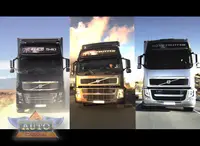Volvo: Heavy Trucks of the Future Will Be Super-Light - VIDEO STORY
STOCKHOLM - June 24, 2009: The Volvo Group’s engineers have created a method for constructing trucks that weigh less while carrying the same loads. Lighter vehicles would entail a significant reduction in fuel consumption and thus carbon dioxide emissions.
Click PLAY to watch video
To date, lightweight technology has mainly been used in Volvo Aero’s aircraft engine components, but engineers at AB Volvo’s research company, Volvo Technology, foresee favorable opportunities in using similar technology to reduce the weight of the cab and chassis in heavy trucks by at least 20% within ten years.
“We are creating the super-light vehicle in a computer program that simulates how hundreds of thousands of small construction alterations can reduce the vehicle’s total weight without affecting other key characteristics in the vehicle, such as crashworthiness or the ability to bear loads,” says Carl Fredrik Hartung, Project Manager at Volvo Technology.
A lighter vehicle, regardless of whether it is a truck or a bus, can be powered by a smaller engine. If the lighter vehicle is equipped with an engine powered by renewable fuel, or hybrid solutions in which the diesel engine is jointly powered with an electric motor, then fuel consumption and thus carbon emissions can be further reduced.
One of the challenges is that a super-light vehicle must be constructed partly with more expensive materials that are highly durable, which means that the vehicle must be manufactured in volumes that are sufficiently large for the cost to be kept down.
“It is important to conduct thorough computer simulations and standardize the manufacturing process so that it will be profitable to manufacture lighter vehicles for commercial use. We have come a long way but a great deal of work remains before the first super-light vehicles hit the road,” says Carl Fredrik Hartung.



